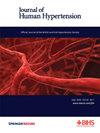在动脉硬度测量中,各种腿裤的影响。
IF 3.4
4区 医学
Q2 PERIPHERAL VASCULAR DISEASE
引用次数: 0
摘要
颈-股脉波速度(cfPWV)被广泛用于测量动脉刚度。由于不同的织物材料和厚度可能会干扰动脉波形,因此参与者在测量期间所穿的腿部裤的类型可能会引入变数。因此,我们研究了普通护腿对使用测压法和测振法测量的cfPWV的影响。我们研究了50名成年人(36名女性),年龄跨度很大(19-78岁)。我们使用两种常用的设备来评估cfPWV,这两种设备使用血压计和袖带振荡传感器来检测股骨脉冲。参与者穿着薄的医用短裤作为参考条件,卡其裤,运动裤和运动短裤,并可选择裸露皮肤的条件(最佳控制),在测量之间休息10分钟。两种装置在不同的腿上产生相似的cfPWV,没有显著的系统差异。在不同类型的腿上,测压装置的cfPWV范围为647 ~ 649 cm/s,测振装置的cfPWV范围为482 ~ 500 cm/s。在裸皮条件下测量的cfPWV平均值与其他护腿没有显着差异。卡其裤的无数据输出率为13%,运动裤为6%,医用短裤、运动短裤和裸露皮肤的无数据输出率为3%,而振荡装置在所有条件下的无数据输出率为0%。我们的结论是,相对较薄的腿裤似乎不会影响cfPWV评估的动脉硬度。然而,硬腿裤,如卡其裤,提出了一个挑战,以检测股脉冲时,使用测压传感器。本文章由计算机程序翻译,如有差异,请以英文原文为准。

Influence of various legwear during arterial stiffness measurement
Carotid-femoral pulse wave velocity (cfPWV) is widely used to measure arterial stiffness. The type of legwear worn by participants during the measurement may introduce variabilities because different fabric materials and thicknesses may disturb arterial waveforms. Therefore, we investigated the impact of common legwear on cfPWV measured using tonometry and oscillometry. We studied 50 adults (36 women) varying widely in age (19–78 years). We evaluated cfPWV using two commonly used devices that detect femoral pulses using tonometric and cuff-based oscillometric sensors. The participants wore thin medical shorts as the reference condition, khaki pants, sweatpants, and athletic shorts, with an optional bare skin condition (optimum control) with 10 min of rest between measurements. Both devices produced similar cfPWV among different legwear with no significant systematic differences. The range of cfPWV was 647–649 cm/s for the tonometric device and 482–500 cm/s for the oscillometric device across different types of legwear. Mean values of cfPWV measured with a bare skin condition did not differ significantly from other legwear. No data output rates were 13% for khaki, 6% for sweatpants, 3% for medical shorts, athletic shorts, and bare skin using the tonometry while the oscillometric device had a 0% no data output rate among all conditions. We concluded that relatively thin legwear did not appear to affect arterial stiffness as assessed by cfPWV. However, stiffer legwear, such as khaki pants, presents a challenge to detect femoral pulses when using a tonometric sensor.
求助全文
通过发布文献求助,成功后即可免费获取论文全文。
去求助
来源期刊

Journal of Human Hypertension
医学-外周血管病
CiteScore
5.20
自引率
3.70%
发文量
126
审稿时长
6-12 weeks
期刊介绍:
Journal of Human Hypertension is published monthly and is of interest to health care professionals who deal with hypertension (specialists, internists, primary care physicians) and public health workers. We believe that our patients benefit from robust scientific data that are based on well conducted clinical trials. We also believe that basic sciences are the foundations on which we build our knowledge of clinical conditions and their management. Towards this end, although we are primarily a clinical based journal, we also welcome suitable basic sciences studies that promote our understanding of human hypertension.
The journal aims to perform the dual role of increasing knowledge in the field of high blood pressure as well as improving the standard of care of patients. The editors will consider for publication all suitable papers dealing directly or indirectly with clinical aspects of hypertension, including but not limited to epidemiology, pathophysiology, therapeutics and basic sciences involving human subjects or tissues. We also consider papers from all specialties such as ophthalmology, cardiology, nephrology, obstetrics and stroke medicine that deal with the various aspects of hypertension and its complications.
 求助内容:
求助内容: 应助结果提醒方式:
应助结果提醒方式:


